Post by mike on Jan 15, 2009 21:50:55 GMT 10
Our classic van fridge was an Electrolux '2 way': this means that it can be switched on to either LPGas, or 240v AC power. ;D
In a van park, with power available to the van, we could plug into 240v and run it on electricity. Without power, we could run it on LPGas... no probs.
On the road travelling, back in the 70's etc, we could keep things cold by running the fridge on LPG.
As more vans 'hit the road' for holidays, it wasn't long before van fridges running on LPG became the source of disastrous fires in service stations as people filling their tanks sometimes had an 'over-filling' incident spraying fuel all around the place... right next to those little LPG flames in the vans. Later, despite 'kick-back' triggers on those petrol pumps, fires still occurred.
Now, legislation to protect everyone, bans use of LPG for fridges while travelling: $2000 fine.
Subsequently, we heard that vanners would still use LPG, but on arrival at servos, would turn off LPG at the 9kg bottle (which would turn the fridge flame off inside). Once out of the servo, the LPG process was re-started.
We just didn't want to burn anyone.
We baulked at the prices ($1600-$2400) being asked for '3way fridges' which would include a third method of cooling: 12v DC from the tow car electrical system. (We could buy bar fridges ie.240v only, for $150; but we already had our Electrolux!).
Our SOLUTION:
Install an INVERTER which would convert our tow-car 12v DC to 240v AC, and run the fridge on 240v... as we travelled.
This effectively creates that THIRD SOURCE of power for our fridge: 12v DC ( we just convert it to something else [240vAC]before its used by the fridge!)
1. Checking the specifications thru the inspection hatch behind the fridge, I found it drew 125watts when on 240v AC.
2. I had read somewhere that when anything electrical is turned on, there is an instant when the wattage required to start can be roughly double the running wattage.
So I reckoned the INVERTER had to be about 300watts (...but it can handle roughly double that for an instant or two). Cheapest 300watt Inverter at the time was $97 at a sale at Dlck Smith Electronics.
3. Wiring:
a. 125watts is about 10.5amps at 12v DC or about the same current as two standard car headlights.
b. I didn't want to wire into the tow car electrical system via the ignition switch with that level of current, so it required 'hot-wiring' the towcar battery positive terminal directly to the inverter in the van. (When the motor is running, the car alternator cuts in and re-charges the battery, as power is drawn off to the van).
This wire (20amp from Supercheap Auto Parts) had to be as large as possible to carry the current to the van to reduce the natural resistance to the current in the wire which results in Voltage drop over that length: say 6metres.
I actually measured it at 1.4v drop from the battery to the end of the 6m wire. That meant that if the fully charged car battery measured 13v across its terminals, it would be 11.6v at the end of the 6m wire. This was CRITICAL, because the invertor sounded an alarm ( a continuous whistle) if the voltage being applied to it was less than 12v, and would cut off operation if the voltage fell below 11.5v!
If need be, I would have bought wiring capable of carrying say 40amps to reduce voltage drop further, to be higher than 11.5v at wire end.
But this was not necessary, and I've had no unexpected problem with the 20amp trailer wire. (Postscript: There was a long term problem: Use 6mm wire as Wahroonga later proposes. See problem at Sept 2010 ... about p4.)
In operation, the 20amp wiring means that the alarm sounds when the engine is NOT running. When the engine is running, the alternator charge keeps the battery voltage high enough for the 'end voltage' to the inverter being greater than 12v, and.. quiet operation when travelling!!!!
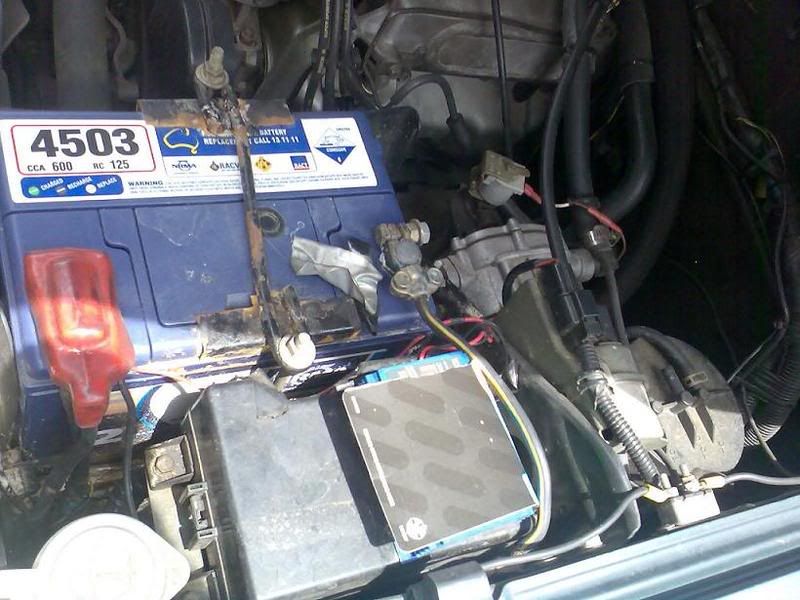
4. A 20 amp 're-setting' fuse was installed in-line near the battery.
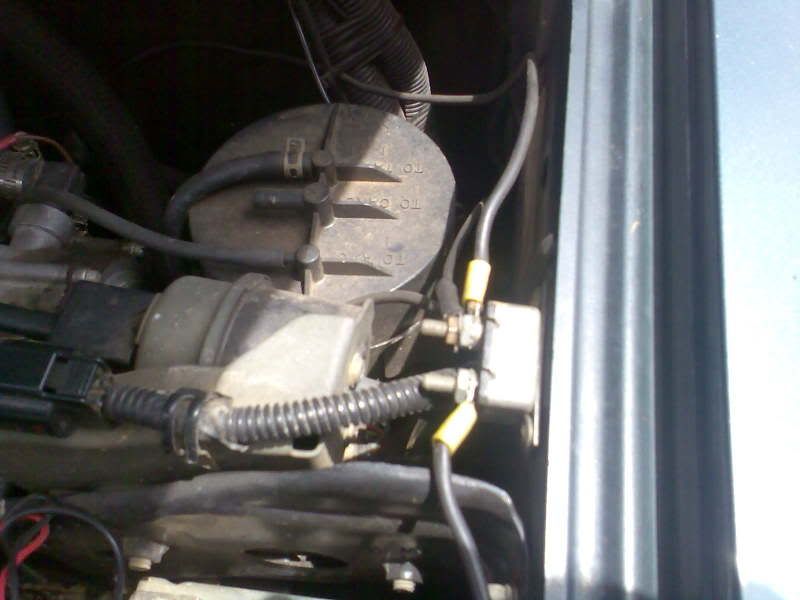
5. A 'Rocker' switch to cut-off this power to the rear of the car was installed on the T bar console by knocking out one of the blank rectangles provided for later installations by the car manufacturer. The 20amp power line was looped up to the terminals of the switch, cut and spade terminals clenched to the wire ends, and then pressed on to the switch terminals.
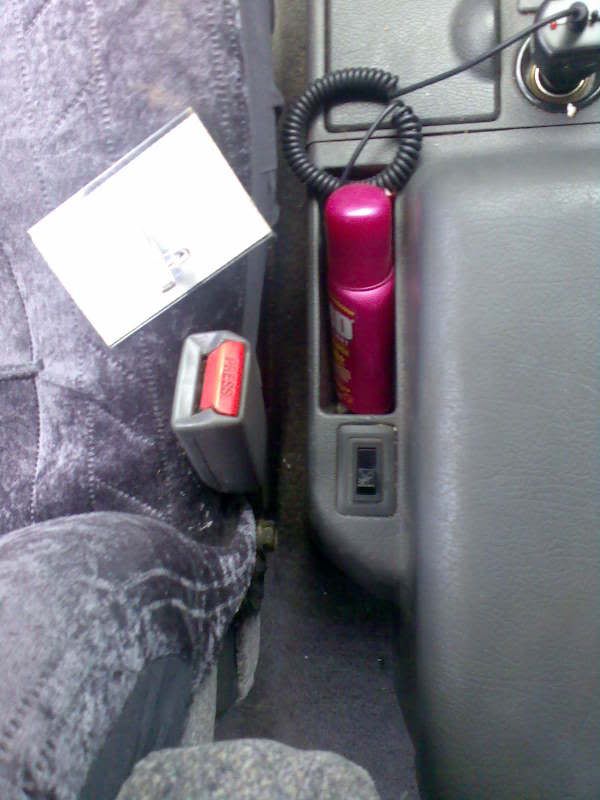
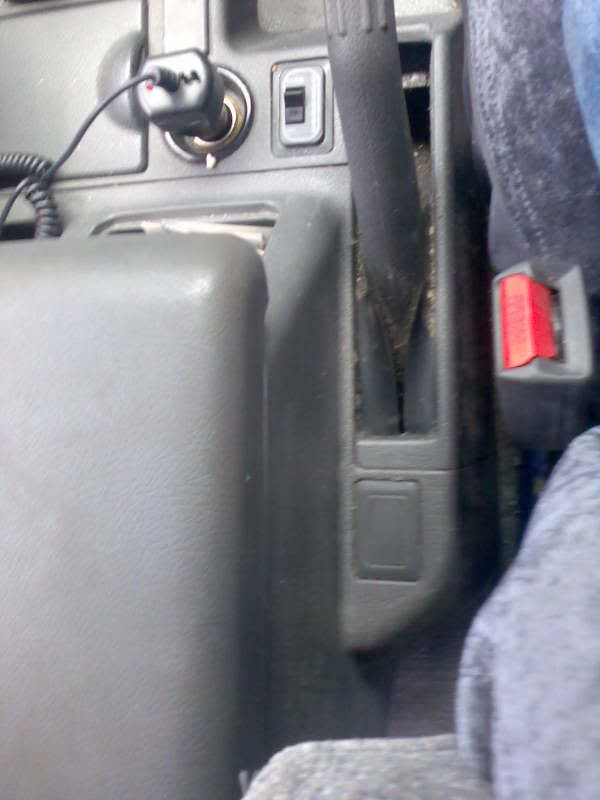
Rocker switch on left. (I know, needs a good clean up round there)!! See spare switch blank example on right: some older classic cars don't have these.
6. At the rear of the car, the wire was then installed (with difficulty) in [the 12v electrical plug to] the small terminal for the line for the 12v internal lighting in the van.
7. VAN. The corresponding plug terminal from the van was then 20amp wired, and the wire 'nylon tied' to the van cable. You can see which terminal has had big current and some 'leakage' in wet weather!
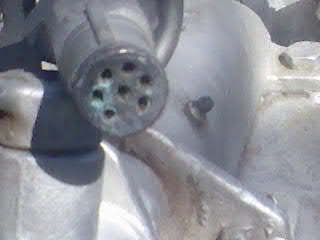
The wire was then stapled under the floor and up into the fridge cupboard.
8. VAN INSIDES....
Nothing changes to the internal switches at the front of the fridge door!
Switch off any 240v first!!!!
Look thru to the back of the fridge and pull out its 3pin 240v plug from its plug base on the van side wall of the fridge cupboard.
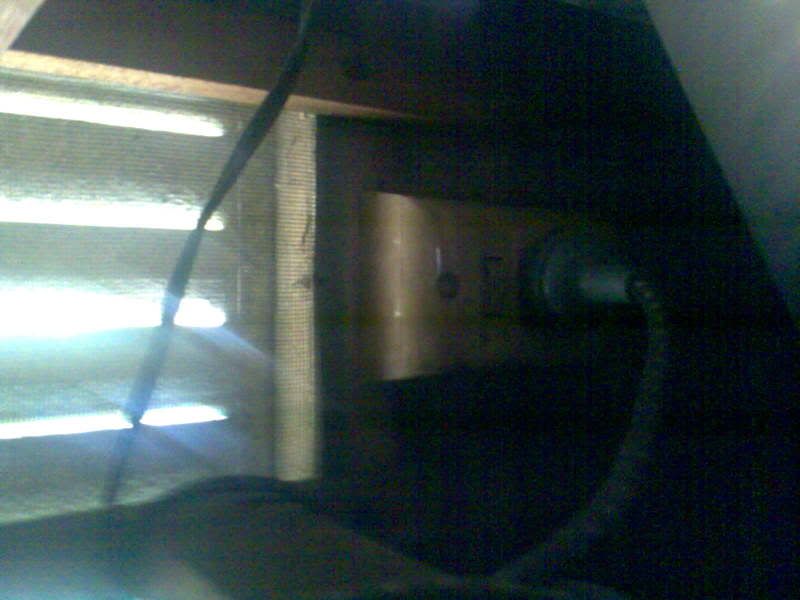
9. Buy a (240v) 'switched' power board at Bunneys, one that has switches to all power plugs. It will have four switched plugs [not 2 as in the pic below]. About $25.
10. That switched power board cord should now be plugged into that 240v plug base at the rear of the fridge, and the 'powerboard' itself is installed in a convenient position to allow the fridge 3pin 240v plug to be plugged in and removed from that power board easily.
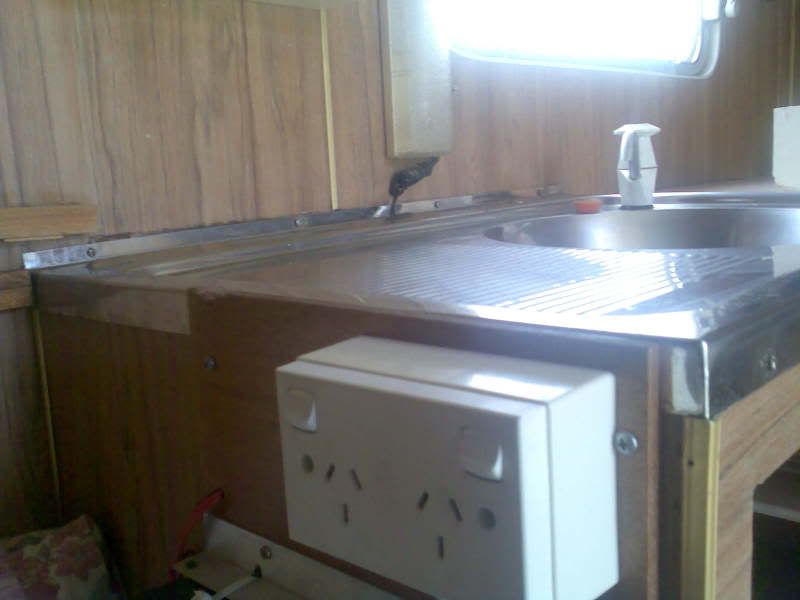
[When the 3pin plug is removed from that powerboard, it will be plugged into the inverter base.]
11. Adjacent to the switched power board, we installed the inverter on its side simply nylon tied to two pieces of alum angle.
This inverter is connected to the 20amp wire bringing 12v DC power from the car battery.
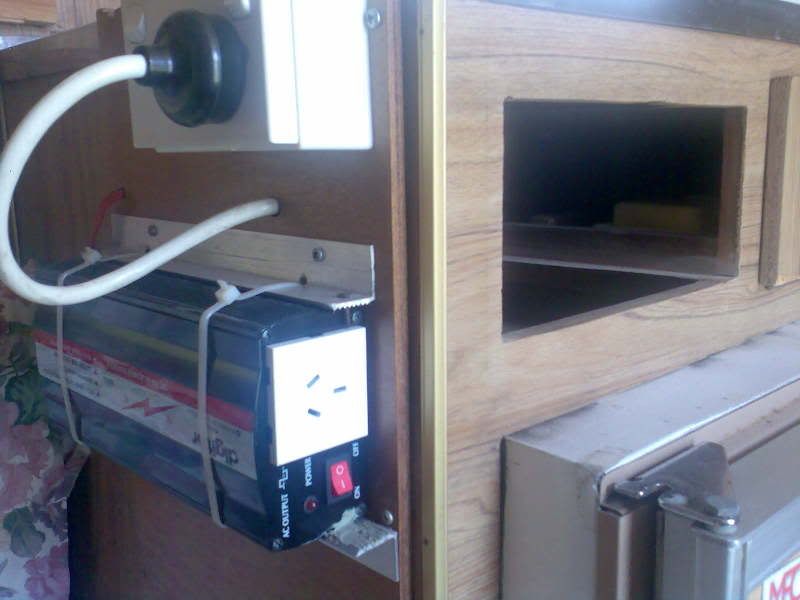
12. The 'negative' or 20amp ground wire from the inverter, we also wired in back to the plug to the rear of the car.... a more direct route than through the van chassis.
In fact, THIS WAS THE BIGGEST PROBLEM WE HAD TO SOLVE. It was eventually solved by connecting an additional 'earth wire' from the car rear plug to a nearby bolt!!! Then, the inverter alarm which kept whistling even with the motor running, STOPPED WHISTLING: WHOO HOO!!!
13. FRIDGE OPERATION...
a. As USUAL: Before setting out, use LPG to 'cool up' the fridge.
b. Turn off LPG at bottle;
c. Turn fridge front door switch from gas to electricity;
NOW...When you're about to go...
d. Plug fridge in to inverter [and turn ON inverter if it has a switch];
e. Check that console switch in car is OFF;
f. Plug van into rear of car;
g. Start car;
h. Turn console switch in car ON. (Check in van that inverter is ON, without alarm sounding: if it does sound,it should go off when car is idled up a bit.).
ON ARRIVAL...
i. When car motor is turned off, turn console switch OFF.
j. In a van park with 240v power, remove plug from inverter and plug into adjacent 240v switched power board, and turn ON.
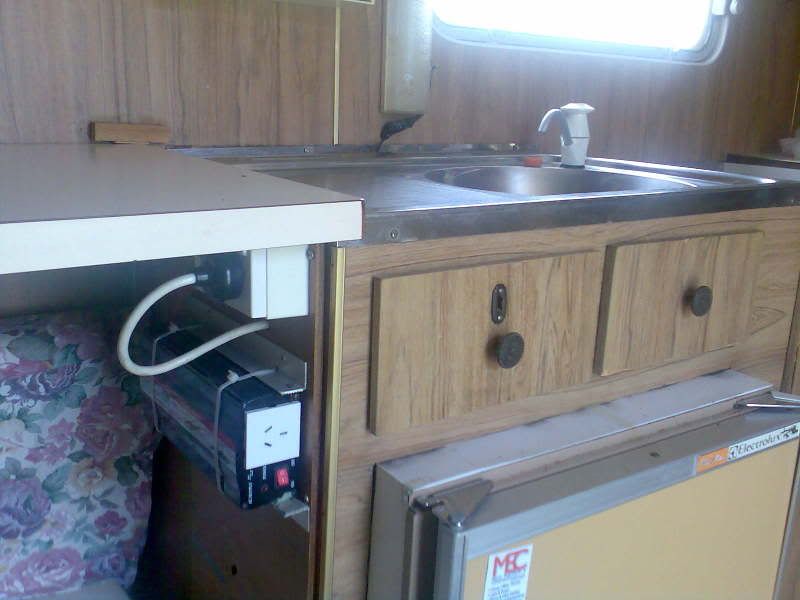
THIS WORKS. ;D


It had to be practical, may not look pretty, but is convenient.
Critical probs were a. voltage drop in that length of wire; b. earth wire back to car.
Cost: Total approx. $127. (I had some stuff already).
Cheers
Mike ;D ;D ;D
In a van park, with power available to the van, we could plug into 240v and run it on electricity. Without power, we could run it on LPGas... no probs.

On the road travelling, back in the 70's etc, we could keep things cold by running the fridge on LPG.
As more vans 'hit the road' for holidays, it wasn't long before van fridges running on LPG became the source of disastrous fires in service stations as people filling their tanks sometimes had an 'over-filling' incident spraying fuel all around the place... right next to those little LPG flames in the vans. Later, despite 'kick-back' triggers on those petrol pumps, fires still occurred.
Now, legislation to protect everyone, bans use of LPG for fridges while travelling: $2000 fine.
Subsequently, we heard that vanners would still use LPG, but on arrival at servos, would turn off LPG at the 9kg bottle (which would turn the fridge flame off inside). Once out of the servo, the LPG process was re-started.
We just didn't want to burn anyone.
We baulked at the prices ($1600-$2400) being asked for '3way fridges' which would include a third method of cooling: 12v DC from the tow car electrical system. (We could buy bar fridges ie.240v only, for $150; but we already had our Electrolux!).
Our SOLUTION:
Install an INVERTER which would convert our tow-car 12v DC to 240v AC, and run the fridge on 240v... as we travelled.
This effectively creates that THIRD SOURCE of power for our fridge: 12v DC ( we just convert it to something else [240vAC]before its used by the fridge!)
1. Checking the specifications thru the inspection hatch behind the fridge, I found it drew 125watts when on 240v AC.
2. I had read somewhere that when anything electrical is turned on, there is an instant when the wattage required to start can be roughly double the running wattage.
So I reckoned the INVERTER had to be about 300watts (...but it can handle roughly double that for an instant or two). Cheapest 300watt Inverter at the time was $97 at a sale at Dlck Smith Electronics.
3. Wiring:
a. 125watts is about 10.5amps at 12v DC or about the same current as two standard car headlights.
b. I didn't want to wire into the tow car electrical system via the ignition switch with that level of current, so it required 'hot-wiring' the towcar battery positive terminal directly to the inverter in the van. (When the motor is running, the car alternator cuts in and re-charges the battery, as power is drawn off to the van).
This wire (20amp from Supercheap Auto Parts) had to be as large as possible to carry the current to the van to reduce the natural resistance to the current in the wire which results in Voltage drop over that length: say 6metres.
I actually measured it at 1.4v drop from the battery to the end of the 6m wire. That meant that if the fully charged car battery measured 13v across its terminals, it would be 11.6v at the end of the 6m wire. This was CRITICAL, because the invertor sounded an alarm ( a continuous whistle) if the voltage being applied to it was less than 12v, and would cut off operation if the voltage fell below 11.5v!
If need be, I would have bought wiring capable of carrying say 40amps to reduce voltage drop further, to be higher than 11.5v at wire end.
But this was not necessary, and I've had no unexpected problem with the 20amp trailer wire. (Postscript: There was a long term problem: Use 6mm wire as Wahroonga later proposes. See problem at Sept 2010 ... about p4.)
In operation, the 20amp wiring means that the alarm sounds when the engine is NOT running. When the engine is running, the alternator charge keeps the battery voltage high enough for the 'end voltage' to the inverter being greater than 12v, and.. quiet operation when travelling!!!!

4. A 20 amp 're-setting' fuse was installed in-line near the battery.

5. A 'Rocker' switch to cut-off this power to the rear of the car was installed on the T bar console by knocking out one of the blank rectangles provided for later installations by the car manufacturer. The 20amp power line was looped up to the terminals of the switch, cut and spade terminals clenched to the wire ends, and then pressed on to the switch terminals.


Rocker switch on left. (I know, needs a good clean up round there)!! See spare switch blank example on right: some older classic cars don't have these.
6. At the rear of the car, the wire was then installed (with difficulty) in [the 12v electrical plug to] the small terminal for the line for the 12v internal lighting in the van.
7. VAN. The corresponding plug terminal from the van was then 20amp wired, and the wire 'nylon tied' to the van cable. You can see which terminal has had big current and some 'leakage' in wet weather!

The wire was then stapled under the floor and up into the fridge cupboard.
8. VAN INSIDES....
Nothing changes to the internal switches at the front of the fridge door!
Switch off any 240v first!!!!
Look thru to the back of the fridge and pull out its 3pin 240v plug from its plug base on the van side wall of the fridge cupboard.

9. Buy a (240v) 'switched' power board at Bunneys, one that has switches to all power plugs. It will have four switched plugs [not 2 as in the pic below]. About $25.
10. That switched power board cord should now be plugged into that 240v plug base at the rear of the fridge, and the 'powerboard' itself is installed in a convenient position to allow the fridge 3pin 240v plug to be plugged in and removed from that power board easily.

[When the 3pin plug is removed from that powerboard, it will be plugged into the inverter base.]
11. Adjacent to the switched power board, we installed the inverter on its side simply nylon tied to two pieces of alum angle.
This inverter is connected to the 20amp wire bringing 12v DC power from the car battery.

12. The 'negative' or 20amp ground wire from the inverter, we also wired in back to the plug to the rear of the car.... a more direct route than through the van chassis.
In fact, THIS WAS THE BIGGEST PROBLEM WE HAD TO SOLVE. It was eventually solved by connecting an additional 'earth wire' from the car rear plug to a nearby bolt!!! Then, the inverter alarm which kept whistling even with the motor running, STOPPED WHISTLING: WHOO HOO!!!
13. FRIDGE OPERATION...
a. As USUAL: Before setting out, use LPG to 'cool up' the fridge.
b. Turn off LPG at bottle;
c. Turn fridge front door switch from gas to electricity;
NOW...When you're about to go...
d. Plug fridge in to inverter [and turn ON inverter if it has a switch];
e. Check that console switch in car is OFF;
f. Plug van into rear of car;
g. Start car;
h. Turn console switch in car ON. (Check in van that inverter is ON, without alarm sounding: if it does sound,it should go off when car is idled up a bit.).
ON ARRIVAL...
i. When car motor is turned off, turn console switch OFF.
j. In a van park with 240v power, remove plug from inverter and plug into adjacent 240v switched power board, and turn ON.

THIS WORKS. ;D



It had to be practical, may not look pretty, but is convenient.
Critical probs were a. voltage drop in that length of wire; b. earth wire back to car.
Cost: Total approx. $127. (I had some stuff already).
Cheers
Mike ;D ;D ;D



 .
.









